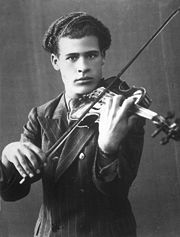
Mahmoud Zoufonoun
Encyclopedia

Life and career

Tar (lute)
The tār is a long-necked, waisted Iranian instrument. It has been adopted by other cultures and Azerbaijan. The word tar itself means "string" in Persian, though it might have the same meaning in languages influenced by Persian or any other branches of Iranian languages like Kurdish...
. Habib began teaching his son the instrument at age 8. Aged twelve, already having become a local teacher for tar, Zoufonoun became interested in the violin
Violin
The violin is a string instrument, usually with four strings tuned in perfect fifths. It is the smallest, highest-pitched member of the violin family of string instruments, which includes the viola and cello....
. Since he was unable to obtain an instrument of his own he designed and made his own instrument.
In the 1930s Zoufonoun moved to Shiraz
Shiraz
Shiraz may refer to:* Shiraz, Iran, a city in Iran* Shiraz County, an administrative subdivision of Iran* Vosketap, Armenia, formerly called ShirazPeople:* Hovhannes Shiraz, Armenian poet* Ara Shiraz, Armenian sculptor...
where he learned musical notes from a clarinet teacher and took lessons in the violin. In 1936 (aged 16) Zoufonoun, at the prompting of his first violin teacher Mr. Vaziritabar, moved to Tehran
Tehran
Tehran , sometimes spelled Teheran, is the capital of Iran and Tehran Province. With an estimated population of 8,429,807; it is also Iran's largest urban area and city, one of the largest cities in Western Asia, and is the world's 19th largest city.In the 20th century, Tehran was subject to...
where he took lessons from Rouben Gregorian. In the early 1940s Zoufonoun began playing solo's on Radio Iran. In 1942 he helped form Anjomane Mooseeghee Melli where he met Rouhollah Khaleghi (who conducted the orchestra).
Zoufonoun worked as a soloist
Solo (music)
In music, a solo is a piece or a section of a piece played or sung by a single performer...
, composer
Composer
A composer is a person who creates music, either by musical notation or oral tradition, for interpretation and performance, or through direct manipulation of sonic material through electronic media...
, arranger
Arrangement
The American Federation of Musicians defines arranging as "the art of preparing and adapting an already written composition for presentation in other than its original form. An arrangement may include reharmonization, paraphrasing, and/or development of a composition, so that it fully represents...
and conductor
Conducting
Conducting is the art of directing a musical performance by way of visible gestures. The primary duties of the conductor are to unify performers, set the tempo, execute clear preparations and beats, and to listen critically and shape the sound of the ensemble...
at the National Radio and Television. He was a member of the “Golha orchestra”. Over the course of his career he has made efforts to compile, transcribe a compilation of regional folk songs, modes, and styles to date. The work is currently uncompleted.
Following his retirement in 1976 from the National Radio and Television, Mahmoud and his family emigrated to the USA. He has continued to teach and compose and perform traditional Persian music, usually with his sons as the Zoufonoun Ensemble
Zoufonoun Ensemble
The Zoufonoun Ensemble is a notable Persian classical music group consisting of Mahmoud Zoufonoun and his four sons Amir Zoufonoun , Ramin Zoufonoun , Amin Zoufonoun , and Omid Zoufonoun...
.
Teaching
Zoufonoun also teaches violin. He currently gives lessons in his private studio and has previously taught at the National School for Iranian Music (of which he was a founding member), The Shabaneh Adult Art School, Institute for the Arts, The University of TehranUniversity of Tehran
The University of Tehran , also known as Tehran University and UT, is Iran's oldest university. Located in Tehran, the university is among the most prestigious in the country, and is consistently selected as the first choice of many applicants in the annual nationwide entrance exam for top Iranian...
, and The Danesh-e Sarah-e Honar.
Honours
On January 20, 2007 Z Venue (an arts non-profit organizationNonprofit organization
Nonprofit organization is neither a legal nor technical definition but generally refers to an organization that uses surplus revenues to achieve its goals, rather than distributing them as profit or dividends...
located in Santa Clara County) presented "A Tribute to Mahmoud Zoufonoun" in the Palace of Fine Arts Theater, San Francisco.
Notable compositions
- Concerto Dashti for Symphony Orchestra
- Tareneh Bayateh Tork (Golha Orchestra; Banan singing)
- Taraneh Mahour: "Gol-o-Zaari" (Lyrics by HafezHafezKhwāja Shamsu d-Dīn Muhammad Hāfez-e Shīrāzī , known by his pen name Hāfez , was a Persian lyric poet. His collected works composed of series of Persian poetry are to be found in the homes of most Iranians, who learn his poems by heart and use them as proverbs and sayings to this day...
) - Naghd-e-Sufi: Suite in Rastpanjgah, including several original Taranehs ("Bovad-aya", "Naghd-e-Sufi", "Baba Taher")
- Faash-Mee-Gooyam: Suite in Chahargah, including original Taranehs ("Sheydaee", "Narm Narmak", "Faash-Mee-Gooyam")
- Heelat-Raha-Kon: Suite in Oshagh, including original Taraneh "Heelat-Raha-Kon"
- Anthem in Chahargah: "Vatan" (Lyrics by Simin BehbahaniSimin BehbahaniSimin Beh'bahāni is one of the most prominent figures of the modern Persian literature and one of the most outstanding amongst the contemporary Persian poets. She is Iran's national poet and an icon of the Iranian intelligentsia and literati who affectionately refer to her as the lioness of Iran...
)
Audio samples
- Mahmoud Zoufonoun playing "Harbi" from his album, "Naghde Sufi"
- Mahmoud Zoufonoun solo intro; Zoufonoun ensemble playing "Boyad Aya" from "Naghde Sufi"
- Mahmoud Zoufonoun playing "Mavalian" from his album, "Naghde Sufi"
All sample tracks original compositions of Mahmoud Zoufonoun from the album "Naghde Sufi"
See also
- Jalal Zolfonun (Zoufonoun)
- Composers of Traditional Persian Music

